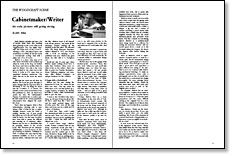
Synopsis: When Andy Marlow started writing about how to make fine furniture, there were no other books on the subject. This article talks about his books and his path to writing, his start in furnituremaking, and his talent for design and proportion. His showroom is in his house; he made all the furniture, and though it’s in daily use, each piece has a little tag on it. If you want it, he’ll empty it out, polish it off, and hand it over. He has just a small shop, and the article details what he uses to make a lifetime’s work. Though not classically trained, Marlow’s advice is useful for woodworkers regardless of their ability level.
Andy Marlow chuckles and says a lot of people think that’s him standing there grinning on the cover of his book Good Furniture You Can Make Yourself. The large man on the cover is wearing a neat, pin-striped apron and would have you think he has just made a Colonial-style rocking chair with a plane and a box of screws.
Marlow is a short, wiry man of 72 who wears old clothes and a peaked cap when he works in his shop out behind the house, and dons a necktie when he quits for dinner. Not only is the cover guy not Marlow, the chair isn’t in the book. It looks as if it came from an unpainted furniture warehouse. The chairs that are in the book are much finer.
Although the work was all done by Marlow, the book has gone through so many changes that he stops just short of disowning it. For one thing, he never met his co-author, F. E. Hoard. For another, it was a nicer book when it was first published in 1952 (in hardcover) under the title The Cabinetmaker’s Treasury. For a third, the co-author and the later resale for its current paperback reincarnation have chipped the royalties away.
That’s what can happen when a fine cabinetmaker, desiring only to pass along a little of what he has so painstakingly learned, turns his hand to writing. Another sort of man would have given up on books and stayed with what he knew, but that man wouldn’t have been able to master the difficult and exacting art of cabinetry, either. Marlow says he was so dissatisfied that he promptly started on his second book, Fine Furniture for the Amateur Cabinetmaker, a tour-de-force on the art of carving in furniture. Published in 1955, it remains the only step-by-step treatment available on how to carve piecrust tables, ball-and-claw feet and the like. Marlow wrote it all himself, took all the pictures, and made all the drawings, besides making all the furniture in the first place. He followed with The Early American Furnituremaker’s Manual in 1973 and finished with a book on inlaying, to be published next year. Marlow has great talent; his wife calls it “a God-given art.”
From Fine Woodworking #4
For the full article, download the PDF below:
Fine Woodworking Recommended Products


Blackwing Pencils

Compass






















Log in or create an account to post a comment.
Sign up Log in